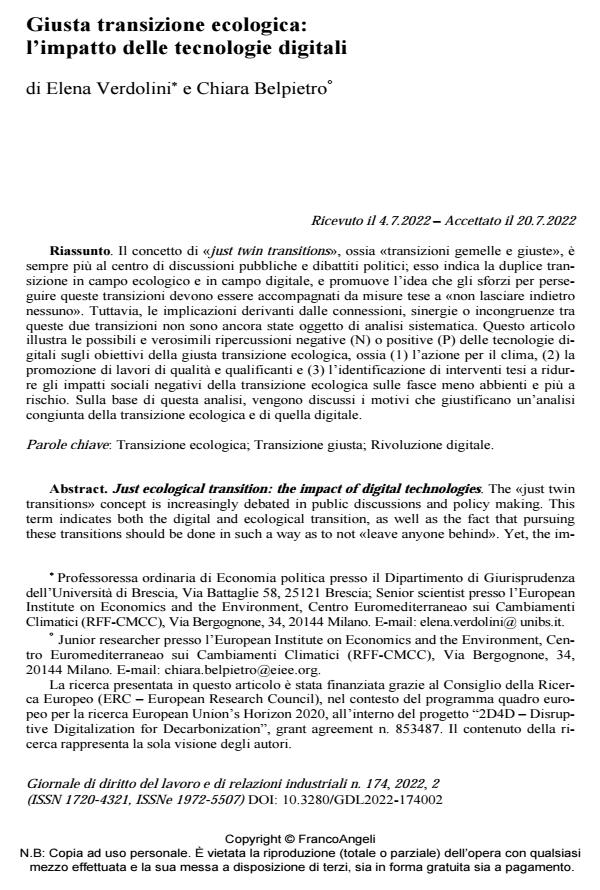Just ecological transition: the impact of digital technologies
Journal title GIORNALE DI DIRITTO DEL LAVORO E DI RELAZIONI INDUSTRIALI
Author/s Elena Verdolini, Chiara Belpietro
Publishing Year 2022 Issue 2022/174
Language Italian Pages 20 P. 205-224 File size 255 KB
DOI 10.3280/GDL2022-174002
DOI is like a bar code for intellectual property: to have more infomation
click here
Below, you can see the article first page
If you want to buy this article in PDF format, you can do it, following the instructions to buy download credits

FrancoAngeli is member of Publishers International Linking Association, Inc (PILA), a not-for-profit association which run the CrossRef service enabling links to and from online scholarly content.
The «just twin transitions» concept is increasingly debated in public discussions and policy making. This term indicates both the digital and ecological transition, as well as the fact that pursuing these transitions should be done in such a way as to not «leave anyone behind». Yet, the implications of digital technologies on the prospects of decarbonisation are currently not sufficiently researched and understood. This article illustrates the potential negative (N) or positive (P) impacts of digital technologies on three key objectives of the just twin transitions: (1) climate change mitigation; (2) promoting high quality and well paid jobs; (3) the identifica-tion of policy interventions which can reduce the negative socio-economic impacts of the eco-logical transition on the more vulnerable households and communities. On these premises, the paper discusses the motivations which justify the joint analysis of the just ecological and digi-tal transitions.
Keywords: Ecological transition; Just transition; Digital revolution.
- Impresa e transizione ecologica: alcuni profili lavoristici Valerio Speziale, in GIORNALE DI DIRITTO DEL LAVORO E DI RELAZIONI INDUSTRIALI 179/2023 pp.283
DOI: 10.3280/GDL2023-179001 - La giusta transizione tra questione sociale e questione ambientale: il potenziale ecologico delle mobilitazioni operaie Emanuele Leonardi, in GIORNALE DI DIRITTO DEL LAVORO E DI RELAZIONI INDUSTRIALI 177/2023 pp.99
DOI: 10.3280/GDL2023-177007 - Giusta transizione ecologica e diseguaglianze: il ruolo del diritto Marzia Barbera, in GIORNALE DI DIRITTO DEL LAVORO E DI RELAZIONI INDUSTRIALI 175/2023 pp.339
DOI: 10.3280/GDL2022-175002 - Sindacato e politiche industriali in transizione. Il caso di industria italiana autobus Charlotte Bez, Angelo Castellani, Emanuela La Rocca, Gianluca Sala, in ECONOMIA E SOCIETÀ REGIONALE 2/2024 pp.41
DOI: 10.3280/ES2024-002004 - Responsabilità sociale d'impresa 2.0 e sostenibilità digitale Lara Lazzeroni, (ISBN:979-12-215-0262-6)
Elena Verdolini, Chiara Belpietro, Giusta transizione ecologica: l’impatto delle tecnologie digitali in "GIORNALE DI DIRITTO DEL LAVORO E DI RELAZIONI INDUSTRIALI " 174/2022, pp 205-224, DOI: 10.3280/GDL2022-174002